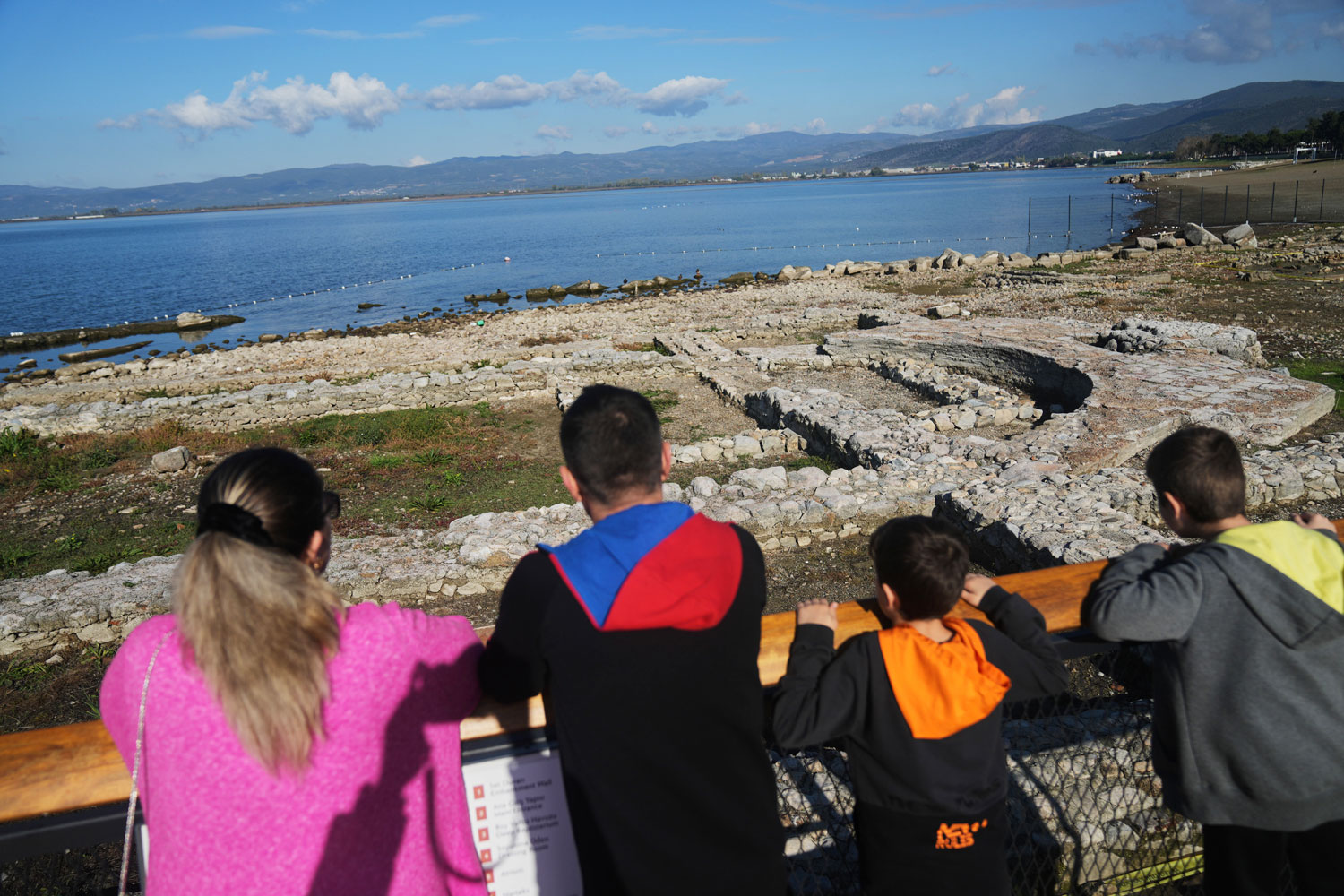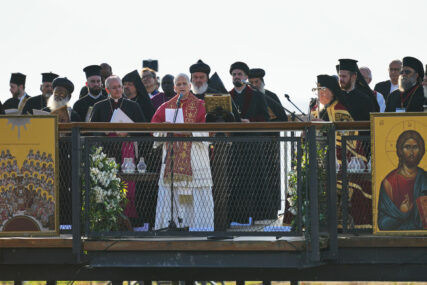
ISTANBUL (RNS) — The Ancient Basilica of Neophytos lay buried beneath the surface of Lake İznik, in Turkey, for more than 1,200 years.
Drought and climate change have caused its stone outline to re-emerge from the waters over the past decade, in time for a special anniversary celebration: the 1,700th anniversary of the Council of Nicaea.
According to some archeologists and historians, the basilica was the meeting place for the roughly 200 bishops convened by Emperor Constantine in 325 to confront a theological crisis and articulate the foundation of their shared Christian faith.
The gathering was known as the first Ecumenical Council of Nicaea, named after the ancient Bithynian city that once existed there. Not much remains of Nicaea — some 10,000 feet of broken walls, a few gates and the faint footprint of an imperial palace are scattered in the Turkish city of İznik. But what is now mostly rubble was the birthplace of the Nicene Creed — a statement of belief shared by almost all Christians today.
And it was before the newly resurfaced ruins of the Basilica of Neophytos that Pope Leo XIV joined with Patriarch Bartholomew of Constantinople and other Christian leaders on Friday (Nov. 28), hoping to recover the same spirit of unity that once animated this lakeshore 17 centuries ago.
Chants accompanied the pope and the patriarch as they walked over the platform leading to the basilica’s remains, where they placed lanterns near two large icons depicting Christ and the Council of Nicaea. Bartholomew, who is largely recognized as the spiritual leader of Eastern Orthodoxy, spoke first, underlining that the event was not just a remembrance of things past, but also a reminder for the present.
“We return to this wellspring of the Christian faith in order to move forward. We refresh ourselves at these inspired waters of rest in order to become strong for the tasks that lie ahead. The power of this place does not reside in what passes away, but in what endures forever,” he said.

Pope Leo XIV and Ecumenical Patriarch Bartholomew I, the spiritual leader of the world’s Eastern Orthodox Christians, lead an ecumenical prayer service at archaeological excavations of the ancient Byzantine-era Christian Saint Neophytos Basilica, in İznik, Turkey, Friday, Nov. 28, 2025, marking the 1,700-year anniversary of the Council of Nicaea. (AP Photo/Khalil Hamra)
After an ecumenical prayer and the reading of the Gospel, Leo observed that “at a period of history marked by many tragic signs, in which people are subjected to countless threats to their very dignity,” the Council of Nicaea offers an opportunity to deepen the faithful’s relationship with Christ, warning against the danger of reducing the figure of Jesus “to a kind of charismatic leader or superman.”
The pope said the anniversary offered a chance for Christians to deepen their bond to one another. “We are all invited to overcome the scandal of the divisions that unfortunately still exist and to nurture the desire for unity for which the Lord Jesus prayed and gave his life,” Leo said, adding that it could also inspire unity in a world “afflicted by violence and conflict.”
The pope also condemned any “use of religion for justifying war, violence or any form of fundamentalism or fanaticism.”
When the Council of Nicaea was convened, the early church was facing internal divisions, with the Alexandrian priest Arius disputing the fully divine nature of Jesus. Constantine, the first Roman emperor to convert to Christianity and to legalize it with the edict of Milan in 313, wished to call all bishops from across the empire to settle the issues tearing at the young religion.
In Nicaea, the council established the fully divine nature of Jesus, set the rules for the celebration of Easter and wrote the Nicene Creed. Christianity eventually splintered into the multiple denominations that exist today, but the ecumenical council represents a first, and lasting, effort to ground the Christian faith in shared principles and beliefs.
It’s that spirit of unity that Pope Leo is trying to revive on this trip, a message made tangible in İznik, where, in 2014, archaeologist Mustafa Şahin uncovered the submerged basilica that once stood near the council’s ancient meeting place.
Aerial photographs taken via helicopter by the Bursa Metropolitan Municipality revealed the outline of the long-lost 2,600-square-foot basilica. Şahin, an archaeologist at the Bursa Uludağ University and the excavation director at İznik, quickly began underwater research and excavations, which continue to this day.
According to Şahin’s analysis, the basilica must have been built to honor Neophytos of Nicaea, who was martyred by Roman soldiers at the age of 16 on the lakeside outside the city in 303 A.D. “The church’s location aligns with the location of Neophytos’ martyrdom,” he told Religion News Service.
Writings by the English pilgrim Willibaldi, who visited Nicaea in 727 A.D., and by Gregory of Caesarea in the ninth century, suggest the Church of Holy Fathers was later built on the ground where the first council was held, Şahin explained.
“Eusebius of Caesarea states that the First Council of Nicaea convened in a small church. The small church he mentions must be the Neophytos church on the lakeshore. Because it was both the site of St. Neophytos’ martyrdom and the site of the First Council, the site is sacred,” he said, adding that this would explain why the church to the Holy Fathers was built outside the city walls, in an unprotected area.
An earthquake in 740 A.D. submerged the basilica beneath the lake, burying its mysteries and significance for centuries. Şahin’s discovery was listed among the top 10 archeological discoveries of the Archeological Institute of America in 2014.
The basilica’s re-emergence mirrors the task that Pope Leo said is facing Christians today: recovering their shared faith and unity buried beneath the weight of time and conflict. As the Rev. Andrea Monge, a Consolata Missionary priest serving in Turkey, put it, this anniversary “is not just the celebration of a beautiful event in the past, but a moment for the church to ask how, even after 16 or 17 centuries, we can renew the freshness of that original paschal experience.”

